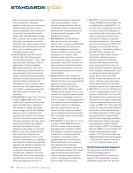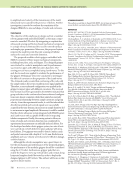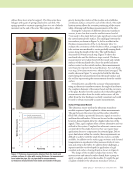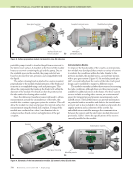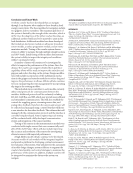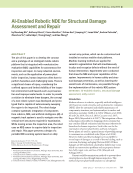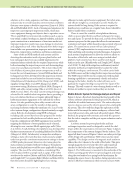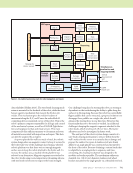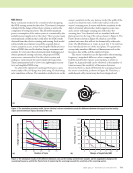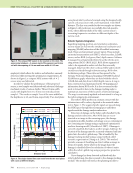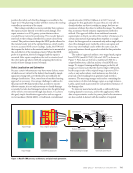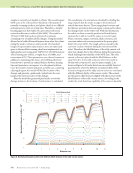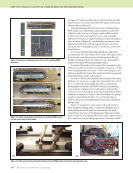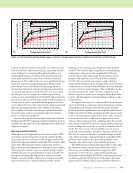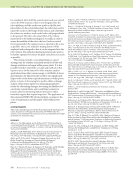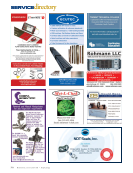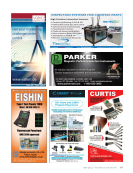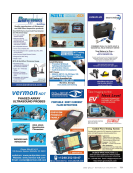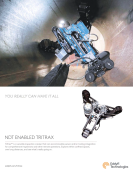736 M A T E R I A L S E V A L U A T I O N • J U L Y 2 0 2 1 the measurements were consistent between 2.5 and 2.6 mm. As noted previously, the flat sensor head does not mate perfectly with the internal tube surface due its curvature. Thus, an offset must be subtracted from the measurement to obtain a more accurate reading. Instrumentation module: To evaluate the LiDAR sensor in the instrumentation module, a template ring was used to simulate a 5 cm diameter surface with a variety of irregularities. During the testing, the module is positioned at the center of the template frame and rotates to scan the surrounding irregularities on the ring. Figure 11 shows the template ring and the instrumentation module positioned at the center. Preliminary results demonstrate the potential for the detection of anomalies in tubes and pipes using a LiDAR sensor. Data from the environmental sensor is also shown and includes pressure (p), altitude (a), and temperature (t). It should be noted that the camera was not installed during this testing. Engineering-Scale Testing To evaluate the crawler’s performance in a larger-scale testbed, a mock-up similar to the superheater tubes found in fossil energy power plants was constructed. The testbed was manufactured with acrylic plastic tubes so the crawler could be observed while navigating through the straight sections and 180° elbows. As shown in Figure 12, the crawler was able to navigate through multiple straight pipe sections and bends and was limited only by the length of the tether. An additional testbed is being constructed with metal tubes and contains sharper bends, as well as 90° elbows. This setup will not allow for visualization of the crawler but will provide a more realistic testbed to evaluate its pull force capability. ME TECHNICAL PAPER w robotic inspection of small-diameter superheater pipes 270 240 210 300 330 30 60 90 120 150 180 0 Radius (mm) Figure 11. Instrumentation module testing: (a) module placed in template ring (b) template ring with anomalies (c) distance measurements obtained in template ring. (a) (b) (c) Figure 12. Crawler navigating the superheater tube mock-up with magnified images.
J U L Y 2 0 2 1 • M A T E R I A L S E V A L U A T I O N 737 Conclusion and Future Work A robotic crawler has been developed that can navigate through 5 cm diameter tubes similar to those found in fossil energy power plants. The base modules for navigation include two grippers and two extenders. The maximum pull force of the system is limited by the strength of the extenders, which is 40 N. Once the drag force of the tether reaches this value, an additional crawler would need to be inserted to assist in the load distribution. Additional modules have been developed that include an electronics module, an ultrasonic transducer sensor module, a surface preparation module, and an instru- mentation module. Testing of the crawler system demon- strates its ability to navigate through multiple straight sections and 180° bends. Initial testing of the modules demonstrates the system’s ability to inspect the integrity and conditions within 5 cm diameter tubes. A number of issues will continue to be investigated in efforts to improve the performance of the system. Since the distance the crawler can navigate is limited by its pull force capability, efforts will be made to improve the extenders and grippers and reduce the drag on the system. Design modifica- tions will include incorporation of the stabilization mecha- nism in the gripper and extender modules to reduce drag and improve the performance in elbows. Efforts will also continue to focus on improving the wire management by incorporating slip rings in the rotating modules. The individual microcontrollers in each module currently utilize serial protocols for communication between the modules. Additional protocols will be evaluated, including RS-485, CAN Bus, and SPI, which may provide more efficient and streamlined communication. This will also establish the controls for supplying power, streaming sensor data, and analog video feedback. Data from the camera and sensors will be collected and managed using a control box that will house a user interface for live video feedback. The software that will manage both the communication protocol and the interface is currently being developed. Future engineering-scale testing will be conducted with a fully developed communication system and integration of the sensor modules. Testing of the sensors in the instrumentation module was conducted with simple sensors that were commercially avail- able off the shelf. Future efforts will also include improving the accuracy and resolution of the sensors by investigating alternate sensors with improved performance. A high-fidelity model will also continue to be developed. Accurate models of each module will be integrated together and provide a platform for developing a virtual environment for evaluation of the system. This will allow for the assessment of module design changes, system additions to augment the crawler’s functionality, and control strategies to maximize the performance of the system. In addition, multiple crawlers will be integrated to maximize the distance the system can navigate. ACKNOWLEDGMENTS The authors would like to thank DOE-NETL for its financial support. This research effort was funded under Award No. DE-FE0031651. REFERENCES Abraham, G.J., V. Kain, and N. Kumar, 2018, “Cracking of Superheater Tube in a Captive Power Plant,” Corrosion Engineering, Science and Tech- nology, Vol. 53, pp. 98–104, https://doi.org/10.1080 /1478422X.2017.1386018 ASTM, 2014, ASTM D1894: Standard Test Method for Static and Kinetic Coefficients of Friction of Plastic Film and Sheeting, ASTM International, West Conshohocken, PA, https://doi.org/10.1520/D1894-14 Balaguer, C., A. Giménez, J.M. Pastor, V.M. Padrón, and M. Abderrahim, 2000, “Climbing Autonomous Robot for Inspection Applications in 3D Complex Environments,” Robotica, Vol. 18, No. 3, pp. 287–297, https://doi.org/10.1017/S0263574799002258 Boxerbaum, A.S., K.M. Shaw, H.J. Chiel, and R.D. Quinn, 2012, “Contin- uous Wave Peristaltic Motion in a Robot,” The International Journal of Robotics Research, Vol. 31, No. 3, pp. 302–318, https://doi.org/10.1177/0278364911432486 Debenest, P., M. Guarnieri, and S. Hirose, 2014, “PipeTron Series – Robots for Pipe Inspection,” Proceedings of the 2014 3rd International Conference on Applied Robotics for the Power Industry, pp. 1–6, https://doi.org/10.1109/CARPI. 2014.7030052 Dehnavi, F., A. Eslami, and F. Ashrafizadeh, 2017, “A Case Study on Failure of Superheater Tubes in an Industrial Power Plant,” Engineering Failure Analysis, Vol. 80, pp. 368–377, https://doi.org/10.1016 /j.engfailanal.2017.07.007 Gargade, A.A., and S.S. Ohol, 2016, “Development of In-pipe Inspection Robot,” IOSR Journal of Mechanical and Civil Engineering, Vol. 13, No. 4, pp. 64–72, https://doi.org/10.9790/1684-1304076472 Hadi, A., A. Hassani, K. Alipour, R. Askari Moghadam, and P. Pourakbarian Niaz, 2020, “Developing an Adaptable Pipe Inspection Robot Using Shape Memory Alloy Actuators,” Journal of Intelligent Material Systems and Structures, Vol. 31, No. 4, pp. 632–647, https://doi.org/10.1177 /1045389X19898255 Ito, F., T. Kawaguchi, Y. Yamada, and T. Nakamura, 2019, “Development of a Peristaltic-Movement Duct-Cleaning Robot for Application to Actual Environment – Examination of Brush Type and Installation Method to Improve Cleaning Efficiency,” Journal of Robotics and Mechatronics, Vol. 31, No. 6, pp. 781–793, https://doi.org/10.20965/jrm.2019.p0781 Kapayeva, S.D., M.J. Bergander, A. Vakhguelt, and S.I. Khairaliyev, 2017, “Remaining Life Assessment for Boiler Tubes Affected by Combined Effect of Wall Thinning and Overheating,” Journal of Vibroengineering, Vol. 19, No. 8, pp. 5892–5907, https://doi.org/10.21595/jve.2017.18219 Kishi, T., M. Ikeuchi, and T. Nakamura, 2015, “Development of a Peri- staltic Crawling Inspection Robot for Half-Inch Pipes Using Pneumatic Artificial Muscles,” SICE Journal of Control, Measurement, and System Inte- gration, Vol. 8, No. 4, pp. 256–264, https://doi.org/10.9746 /jcmsi.8.256 La Rosa, G., M. Messina, G. Muscato, and R. Sinatra, 2002, “A Low-Cost Lightweight Climbing Robot for the Inspection of Vertical Surfaces,” Mechatronics, Vol. 12, No. 1, pp. 71–96, https://doi.org/10.1016 /S0957-4158(00)00046-5 Longo, D., and G. Muscato, 2004, “A Modular Approach for the Design of the Alicia3 Climbing Robot for Industrial Inspection,” Industrial Robot, Vol. 31, No. 2, pp. 148–158, https://doi.org/10.1108 /01439910410522838 Nagase, J.-Y., F. Fukunaga, and Y. Shigemoto, 2016, “Cylindrical Elastic Crawler Mechanism for Pipe Inspection,” Advances in Cooperative Robotics, pp. 304–311, https://doi.org/10.1142/9789813149137_0037 Nagase, J., K. Suzumori, and N. Saga, 2013, “Development of Worm-Rack Driven Cylindrical Crawler Unit,” Journal of Advanced Mechanical Design, Systems, and Manufacturing, Vol. 7, No. 3, pp. 422–431, https://doi.org/10.1299/jamdsm.7.422
ASNT grants non-exclusive, non-transferable license of this material to . All rights reserved. © ASNT 2025. To report unauthorized use, contact: customersupport@asnt.org



























































